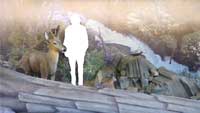(Creation Residence )
L'animal a l'esquena (Celrà)
From 04/07/2011 to 17/07/2011
Presentation :
On 15/07/2011 at 20:00 in L'animal a l'esquena (Celrà)
SOCIEDAD DOCTOR ALONSO
( Sofia Asencio )
 Estela is the second part of Ramon 2108 which was premiered in 2008 in the T6 dance cycle within a program called Mascletá. Three choreographers were proposed to work on the XXth Century man. I presented a 130 years old man who was eternally young but whose thinking skills and communication were reducing by a society which is becoming more and more mediocre everyday.
Estela is the second part of Ramon 2108 which was premiered in 2008 in the T6 dance cycle within a program called Mascletá. Three choreographers were proposed to work on the XXth Century man. I presented a 130 years old man who was eternally young but whose thinking skills and communication were reducing by a society which is becoming more and more mediocre everyday.
The piece was a reconstruction of the present and a love story. I felt at that moment that the piece was begging for a second part but I hadn't decided to go for it till now. We want to work on Estela in L'Animal a l'Esquena.
Time surprises me; it is obvious, but still relevant.
A week ago we travelled to Argentina carrying our occidental story behind. When I saw Esquel, a town located in the province of Chubut, Patagonia, I thought it was a 40 years old village with prefabricated houses. My European head thought: how young! What a short history they have!
They do have history, but they hardly know about it because, us the colonizers ruined it. But my thought wasn't quite going in that direction, it was closer to the idea of measuring things regarding time, and suddenly we were taken in front of a 2600 years old alerce (a type of tree from the Parque of Alerces) and I planted myself there thinking that all our history was concentrated within a of 2,2 m diameter trunk.
This has been the more intense experience I have had regarding Greek culture and it happened in Argentina.
http://www.doctoralonso.org
Estela is about time
It is a long time now that I think about oldness.
An old person on stage appeals somehow to something ideological
It is normal.
Ester Ferrer is performing naked now, she says that it is now that her body is interesting.
However, what we are interested in is not so much time in terms of accumulation but time in relative terms.
We play to create a different time on stage to that of outside.
Time, understood as a division of hours and days is a preestablished "universal" term. The duration of a performance is also something which is agreed on by the artist and the theatre, however the perception of that time belongs to the field of singularity. I would like to traverse that singularity.
Sofia Asencio
L'animal a l'esquena (Celrà)
From 04/07/2011 to 17/07/2011
Presentation :
On 15/07/2011 at 20:00 in L'animal a l'esquena (Celrà)
SOCIEDAD DOCTOR ALONSO
( Sofia Asencio )
 Estela is the second part of Ramon 2108 which was premiered in 2008 in the T6 dance cycle within a program called Mascletá. Three choreographers were proposed to work on the XXth Century man. I presented a 130 years old man who was eternally young but whose thinking skills and communication were reducing by a society which is becoming more and more mediocre everyday.
Estela is the second part of Ramon 2108 which was premiered in 2008 in the T6 dance cycle within a program called Mascletá. Three choreographers were proposed to work on the XXth Century man. I presented a 130 years old man who was eternally young but whose thinking skills and communication were reducing by a society which is becoming more and more mediocre everyday.
The piece was a reconstruction of the present and a love story. I felt at that moment that the piece was begging for a second part but I hadn't decided to go for it till now. We want to work on Estela in L'Animal a l'Esquena.
Time surprises me; it is obvious, but still relevant.
A week ago we travelled to Argentina carrying our occidental story behind. When I saw Esquel, a town located in the province of Chubut, Patagonia, I thought it was a 40 years old village with prefabricated houses. My European head thought: how young! What a short history they have!
They do have history, but they hardly know about it because, us the colonizers ruined it. But my thought wasn't quite going in that direction, it was closer to the idea of measuring things regarding time, and suddenly we were taken in front of a 2600 years old alerce (a type of tree from the Parque of Alerces) and I planted myself there thinking that all our history was concentrated within a of 2,2 m diameter trunk.
This has been the more intense experience I have had regarding Greek culture and it happened in Argentina.
http://www.doctoralonso.org
Estela is about time
It is a long time now that I think about oldness.
An old person on stage appeals somehow to something ideological
It is normal.
Ester Ferrer is performing naked now, she says that it is now that her body is interesting.
However, what we are interested in is not so much time in terms of accumulation but time in relative terms.
We play to create a different time on stage to that of outside.
Time, understood as a division of hours and days is a preestablished "universal" term. The duration of a performance is also something which is agreed on by the artist and the theatre, however the perception of that time belongs to the field of singularity. I would like to traverse that singularity.
Sofia Asencio